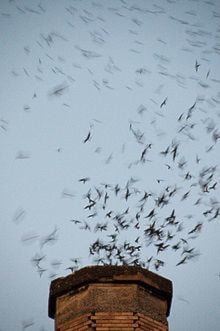What do hummingbirds and swifts' have in common; I would have thought nothing at all!
However, they are the only two birds to share the classification of "apodiformes," which translated from Latin means "without feet."
Both species have very weak legs and feet resulting in a life on the wing being unable to walk or perch. Long arcing primary wing feathers are another common feature making them proficient fliers and well suited to complex mid-air manoeuvres.
There are four kinds of swifts in North America, the black, white throated, chimney (found in the east) and the Vaux's (only found in the west). The Vaux's swift is the smallest of the four migratory species, standing only 4 and a half inches.
Like the hummingbirds the swifts cover vast distances during their migration, the Vaux's cover the greatest distance leaving the British Columbia coastal area in September flying to Central America, returning to our coast in April.
There is little difference in coloration between the adults and juveniles, they have small dark grey-brown bodies and long swept-back pointed wings; their bills are short as are their tails that are equipped with "bristles."
In flight, Vaux's swifts have pronounced stiff wing beats and when preparing to roost they descend in a dramatic spiralling formation resembling a small tornado being sucked into a hole.
Once in their roost, which is usually a dead hollow tree or chimney, they cling to the vertical side of the structure bracing their bodies with their stiff tails. Vaux's swifts prefer to live in old growth forests in snag trees but sadly this habitat is quickly disappearing.
In some areas they have adapted to chimneys for roosting or have accepted artificial tall wooden boxes, these have successfully been used in the West Kootenays. These swifts are one of the fastest fliers in bird land and are strictly insectivores; they have been known to consume over 20,000 insects per bird in one day capturing all their food and water on the wing.
Just as remarkable is their ability to pick up nesting materials in their mouths and even break off twigs all without putting a foot down; these little flying machines leave their roost at daybreak and return at dusk without resting.
Vaux's swifts are also able to regulate their body temperatures and like hummingbirds can lower their temperature at night and go to a state of torpor. Nests are constructed in hollow trees by a mated pair only one couple per tree, they collect and stick twigs to the vertical surface inside the tree using saliva produced by enlarged saliva glands that can produce copious amounts of "spit."
There is concern over the future of the swifts, as their habitat is fast disappearing. Old brick chimneys are being replaced by more modern heating systems and old-growth forests are giving way to urban expansion.
Although there have been reports of large flocks of swifts in the Comox Valley, especially in Cumberland and in Courtenay that descended into chimneys, they often go unreported. A few weeks ago MARS was alerted to a report of a huge flock descending into the chimney of the same house they visited six years ago.
The first visit ended with the swifts leaving after a messy and I am sure stressful encounter for both birds and homeowner. Unfortunately this time what started as a rescue mission, ended tragically with 1,350 birds losing their lives.
All the birds were taken to MARS, where they were counted, recorded and then transferred to the Thompson River University in Kamloops and the Canadian Wildlife Service for necropsy becoming part of an international study by a group of conservationists.
Due to their food preference focus has to be on the possibility that they ingested toxic or poisoned insects during the migration, or once they arrived in the Comox Valley. The fateful chimney has been screened and capped and hopefully will not be used again, however other swifts have been seen in this area and they may respond to artificial roost sites.
There are studies being conducted by local biologists on the annual visitors in the Seattle and Portland areas, to help with future conservation and management of these highly complex birds.
Please call MARS to let us know if you see any of the swifts in your area with their location so that we can pass on this information for the studies. To report orphaned or injured wildlife, please call 1-800-304-9968 all other calls 250-337-2021.
For updates and further information on recovering patients visit www.wingtips.org.
Sandy Fairfield is the educational co-ordinator for the Mountainaire Avian Rescue Society (MARS). The MARS column appears every second Friday.
